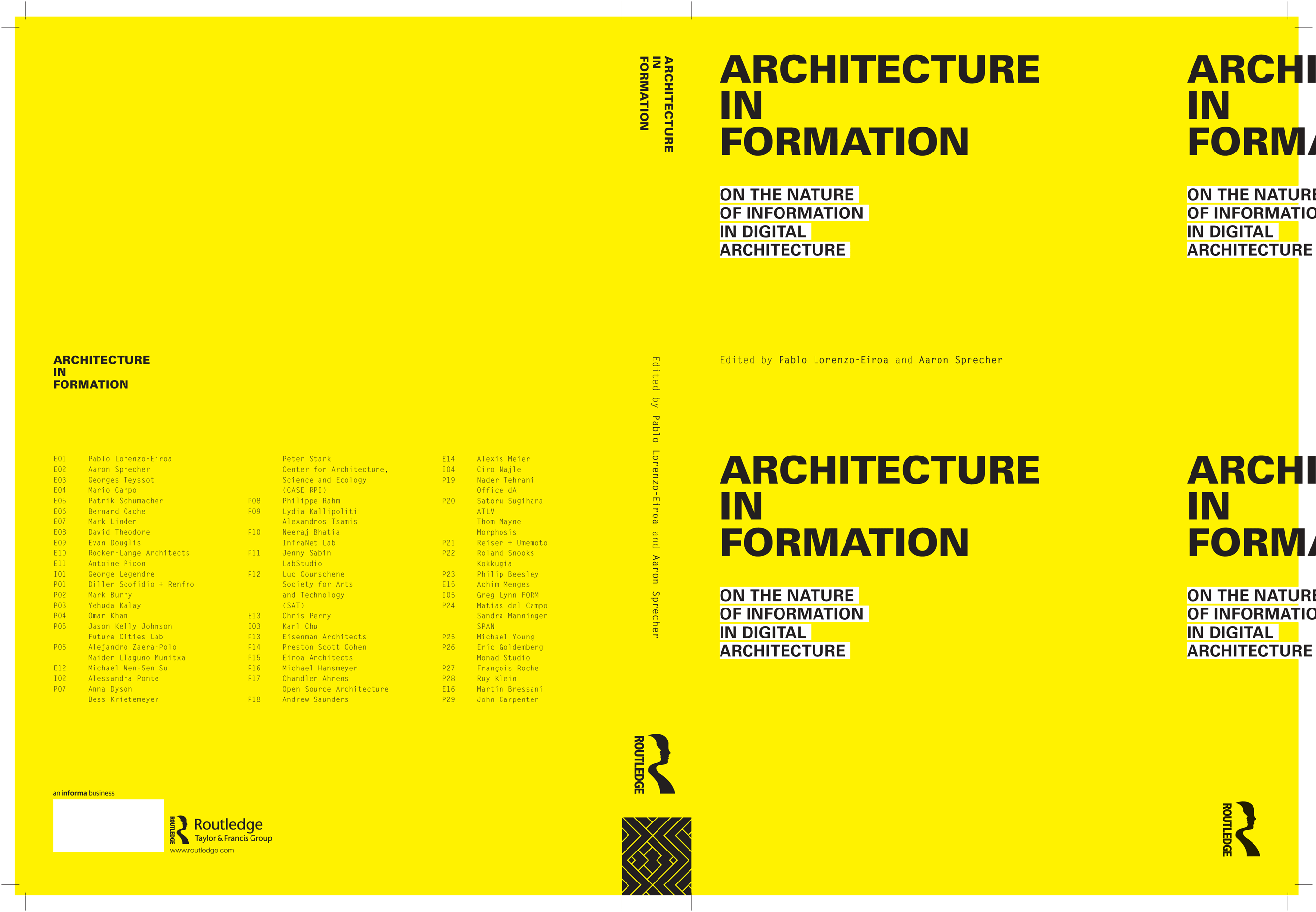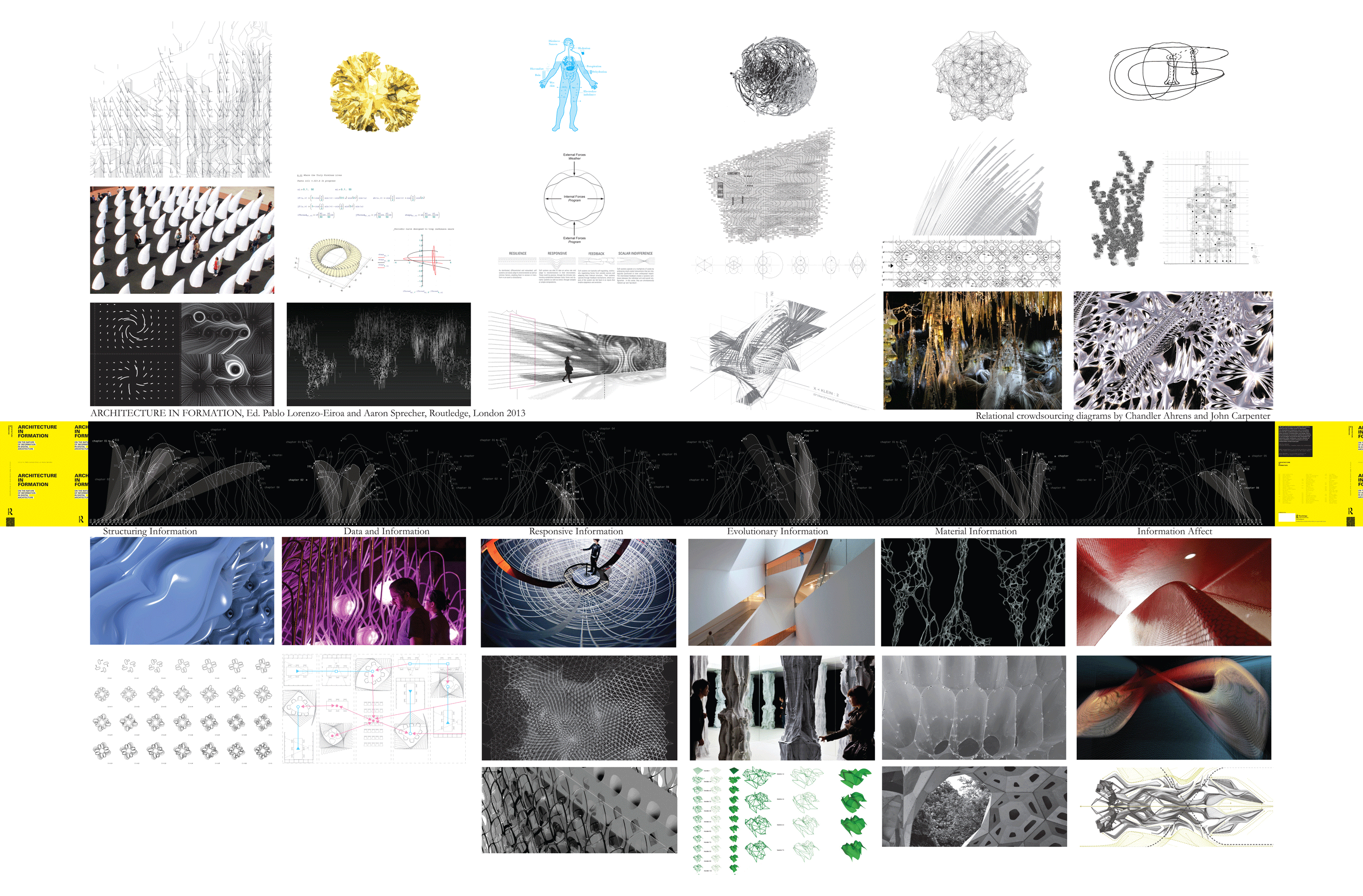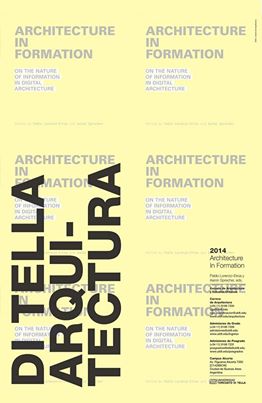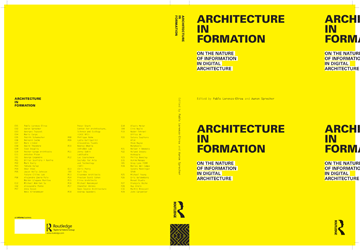
2013 Book
publication. Pablo Lorenzo-Eiroa and
Aaron Sprecher co-edited
a new upcomming book publication
entitled Architecture in Formation to be released
in 2013 after a peer review process with Routledge/Taylor and
Francis Publishing.
Architecture In Formation,On The Nature of Information
in Digital Architecture Edited by Pablo Lorenzo-Eiroa
and Aaron Sprecher, Routledge, New York 2013
http://www.routledge.com/books/details/9780415534901/

Architecture in Formation is the first digital
architecture manual that bridges multiple relationships
between theory and practice, proposing a vital resource
to structure the upcoming second digital revolution.
Sixteen essays from practitioners, historians and
theorists look at how information processing informs and
is informed by architecture. Twenty-nine experimental
projects propose radical means to inform the new
upcoming digital architecture.
“We grew accustomed to live together with machines,
which provide us endless access to information. Our
computational companions, now in our pockets, have had
also a profound impact on how we foresee future
scenarios of transformation and change. Now is the
moment that we reconsider critically the emergence of
new paradigms and protocols that computation has
determined within architecture, and this collection of
essays establishes a potent cornerstone of a much needed
history of that recent past.”
Fabrizio Gallanti, Associate Director, Canadian Centre
for Architecture.
Featuring essays by: Pablo Lorenzo-Eiroa, Aaron
Sprecher, Georges Teyssot, Mario Carpo, Patrik
Schumacher, Bernard Cache, Mark Linder, David Theodore,
Evan Douglis, Ingeborg Rocker and Christian Lange,
Antoine Picon, Michael Wen-Sen Su, Chris Perry, Alexis
Meier, Achim Menges and Martin Bressani.
Interviews with: George Legendre, Alessandra Ponte, Karl
Chu, CiroNajle, and Greg Lynn
Projects by: Diller Scofidio + Renfro; Mark Burry;
Yehuda Kalay; Omar Khan; Jason Kelly Johnson, Future
Cities Lab; Alejandro Zaera-Polo and Maider Llaguno
Munitxa; Anna Dyson / Bess Krietemeyer, Peter Stark,
Center for Architecture, Science and Ecology (CASE);
Philippe Rahm; Lydia Kallipoliti and Alexandros Tsamis;
Neeraj Bhatia, Infranet Lab; Jenny Sabin, Lab Studio;
Luc Courschene, Society for Arts and Technology (SAT);
Eisenman Architects; Preston Scott Cohen; Eiroa
Architects; Michael Hansmeyer; Open Source Architecture;
Andrew Saunders; Nader Tehrani, Office dA; Satoru
Sugihara, ATLV and Thom Mayne, Morphosis; Reiser +
Umemoto; Roland Snooks, Kokkugia; Philip Beesley; Matias
del Campo and Sandra Manninger SPAN; Michael Young; Eric
Goldemberg, Monad Studio; Francois Roche; Ruy Klein;
Chandler Ahrens and John Carpenter.
Pablo Lorenzo-Eiroa is an associate professor adjunct at
The School of Architecture of The Cooper Union.
Aaron Sprecher is an assistant professor at McGill
University School of Architecture.
Editors: Pablo
Lorenzo-Eiroa and Aaron Sprecher; Copy Editor: Michael Wen-Sen
Su; Graphic Designer: Atelier Pastille Rose; Crowdsourcing
Diagrams: Chandler Ahrens and John Carpenter; Translation:
Barbara McClintock;
Editorial
Collaborators: Eduardo Alfonso, Zulaikha Ayub, Luo Xuan.
http://www.routledge.com/books/details/9780415534901/
pre-order at
amazon.com:
http://www.amazon.com/Architecture-Formation-Nature-Information-Digital/dp/0415534909/ref=sr_1_8?s=books&ie=UTF8&qid=1363646167&sr=1-8&keywords=architecture+in+formation
INTRODUCTION:
[excerpt]
Architecture in Formation comprises a dialog among architectural
theorists, historians, and experimental architects based on the
many and complex relationships between information processing
and its representation. This collection of historical
examinations, critical essays, and design projects provides a
cross analysis that aims to re-conceptualize the current state
of the discipline of architecture as it has become, of late,
increasingly structured around advances in computation.
We follow the trajectory of a critical, alternative axis
deviating from the way digital technology has usually been
understood since its widespread adoption in the 1990’s. While
previous trajectories privileged a visual logic, thus repressing
digital architecture to a merely representational role, we
emphasize the architectural specificity of a disciplinary
potential, which recognizes the role of computation in actually
processing the relational capacity of systems and structures.
Our ambition is to produce both a historical venture against the
mere actualization of technology and an intellectual
understanding of the digital project through the more
generalized notion of Information. However, we are not proposing
to dismiss visual and formal logic. Rather, we hope to foster
the integration of these levels of cognition and representation
with deeper, usually inaccessible, relational structures.
An architecture of information implies the constitution of a
critical, intermediary, and abstract interface-space that is
capable of transforming the discipline by mediating the
relationships among cognitive structures, codes, information
processing, and form. The associated disciplinary shift drives a
general movement towards engaging an emergent, formal aesthetic
that is based upon profound structuring relationships. In
particular, due to the increasing ease of writing and
manipulating computer programming codes, the architecture
community recently began to question the hidden, form-giving
roles of software developers, thereby precipitating a new
“deconstruction” of software structures to produce novel,
unexpected modes of architectural design. Yet, this questioning
also provoked the emergence of a form of structuralism, one that
would have to be displaced in order to avoid the idealistic
dimension of the architectural object – even as the object
itself becomes invisibly embedded into reactive and dynamic
systems. Such an object-system, then, would necessarily consider
architectural design in terms of latent possibilities.
In this volume, the architectural questions inferred by
information structures and interfaces have been framed through
our combined dialectical and editorial voices, the result of
which necessarily redefines both the limits and nature of the
discipline. Specifically, our dialectical positions address the
intrinsic, disciplinary notions of representation, information
standardization, and formal autonomy, as well as extrinsic
notions regarding the boundaries of the discipline. This
dialectical approach is investigated in three forms: interviews,
curated essays, project essays and experimental projects, the
summation of which generates the necessary conflicts,
contradictions, and continuities capable of reorganizing certain
fundamentals of the discipline as it continues to expand through
computation.
This book consists of six chapters. Each chapter in this book
begins with an interview and ends with an extended, critical
essay. Together, they frame the chapter’s specific discourse
Inquiring the nature of information. By specifically fostering a
progression from conceptual to perceptual structures, each
chapter reveals a particular cartography of influences and cross
relationships of the featured theorists, historians, and
practitioners. This cartography takes the form of a
crowdsourcing diagram depicting the informational content of
each chapter, thereby offering alternative, formal readings of
the chapter. The six chapters are:
Chapter 1, Structuring Information introduces the historical,
theoretical, and conceptual backgrounds underlying current
architectural explorations of various information systems,
codes, and cognitive structures. In this chapter, architectural
historians, theoreticians, and experimental practitioners
question the multi-layered role of information in architecture.
Chapter 2, Information Interfaces explores the nature of
abstract systems that process data and induce information. This
chapter includes an overview of relational systems in
architecture – in particular, the mathematical principles and
protocols that layer information.
Chapter 3, Responsive Information investigates interactive
systems in the context of the contemporary production of spaces
and environments. This third topological level features
experimental projects and essays expressing the potential of
responsive systems in terms of their spatial and programmatic
organizations.
Chapter 4, Evolutionary Information addresses questions
regarding both the use of evolutionary protocols in architecture
and the innovations arising out of evolutionary, time-based
architectural systems and topologies.
Chapter 5, Material Information focuses on the extensive aspects
of information systems through an investigation of the various
processing logics derived from forces acting upon materials –
even as these systems challenge categories and intuitive
assumptions..
Chapter 6, Information Affect extends the preceding discourse on
materiality, while also scrutinizing the role of deep structures
– both relative to the output of information, and within the
context of spatial perception.
2014 July:
Architecture In Formation, ed. Pablo Lorenzo-Eiroa and
Aaron Sprecher has been featured and reviewed in
Archinect by
Amelia
Taylor-Hochberg.
2014 The book
Architecture In Formation, edited by Pablo
Lorenzo-Eiroa and Aaron Sprecher is being exhibited at
The Di Tella University in Buenos Aires. Julian Varas,
director CEAC. School of Architecture Dean Ciro Najle.
2014 Pablo
Lorenzo-Eiroa and Aaron Sprecher, Editors of
Architecture In Formation were interviewed by the Young Architects Forum-Connection 12.04 of the
AIA - American Institute of Architects.




